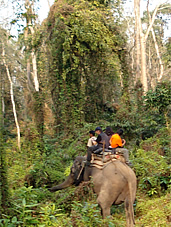 |
Nepal National Parks Chitwan |
|
|
 |
Chitwan National Park: Leopard set free
February
2003 |
The
Park Officials set a leopard free in the park. The wild leopard was captured
from Tin Thana VDC of Kirtipur after it started attacking the locals and
domestic cattle in the VDC. The officials had captured the leopard four
days ago
top
Chitwan National Park: Royal Bengal tigers killed
January
2003 |
 |
At
the Chitwan National Park a tigress was shot dead by park officials
in self-defence recently.
A
Royal Bengal Tiger has died due to poisoning in the Royal Bardiya National
Park. Another tiger has been shot dead in the Chitwan National Park.
The incident of poisoning has occurred barely two weeks after the death
of five spotted deer in Bardiya after eating grass laced with pesticide. |
top
Chitwan National Park: Poachers killed rhinos
December
2002 |
According
to Park officials, Poachers shot dead eight of the14 one-horned rhinos
found dead in the protected Chitwan National Park in the five months.
Poachers escaped with six horns.
Tigers
killed two calves and eight others died naturally. Two tigers and one leopard
have died in more than four months.
top
Depleting
of grassland in Chitwan Park endangers birds
October
2002 |

|
 |
Due
to floods and swelling of rivers and streams inside the Royal Chitawan
National Park, hundreds of hectares of grassland have been converted into
bare river banks badly affecting the existence of rare species of birds
normally sheltering there. |
 |
 |
| Heron |
Florican |
|
Water-cock |
Lapwing |
These birds usually reproduce during the monsoon
season, but due to the floods the nests and the eggs have been destroyed.
Experts
and bird-watchers lament that birds that normally migrate to this place,
have started to abandon their usual niche here. 20 percent of the grassland
region of the park is declining every year.
As
a result of the flooding of the Rapti river, Budhirapti river, the Dhungre
stream and many other streams, 500 hectares of grassland, as well as 50
hectares of forest region have been waterlogged and covered in sand.
Due
to this flooding those native birds living at the Bishajari as well as
those coming in from other parts, around 120 different species of birds
have been adversely affected. Lack of a shelter, have rendered species
such as Heron, Florican, Lapwing, water-cocks, homeless and endangering
their survival. Of the more than 500 species of birds found in the Royal
Chitawan National Park, more than 100 species are directly and indirectly
dependent upon the grassland. The main bird watching site at Bishajari
region holds around 150 varieties of birds of which around 20 have flown
down here from Siberia, Sri Lanka, India and many other places.
Though
birds have been affected the most by the depletion of the grassland, the
depletion has also affected wild animals like rhinoceros, deer, elephant
and many others. After the tall grass in the interiors was destroyed, the
animals searching for fodder started to enter paddy plantations in the
mid-region.
top
Gandak
Barrage poses threat to crocodile life
September
2002 |
 |
The
Gandak Barrage built on the mighty Narayani River at Tribeni has been posing
threats to conservation efforts of endangered crocodile, according to crocodile
experts. The Ghadiyal crocodile is listed as an endangered reptile due
to its diminishing population the world over.The Royal Chitwan National
Park releases thousands of young Ghadiyal and Magarmach crocodiles into
the river to maintain the population of these two species of reptiles. |
Crocodile
experts say there has been a negative impact on the life cycle of these
endangered amphibians due to the barrage that remains opened during the
monsoon and closed down during the dry season. When the barrage is opened
during the monsoon the swelling river sweeps all the young crocodiles away
towards India and they cannot come upstream because of the closure of the
barrage during the dry season.
The
life cycles of other aquatic animals such as fish and tortoises are in
danger, as their movement is also blocked during their breeding seasons."It
is meaningless to hatch them here if they cannot be preserved," said the
expert, "We have found a large number of crocodile finger-links (young)
in paddy fields in India." He said most of them die there with recession
of the monsoon and others cannot swim upstream because the barrage blocks
their way.Since its establishment in 1978, Crocodile Breeding Center has
already released around 1,000 crocodiles in Narayani, Kaligandaki, Kosi
and Babai Rivers. Last year, the centre released 10 more crocodiles in
the Narayani River in a bid to maintain its population. Survival rate of
these crocodiles is only 30 per cent and it takes almost three years for
them to grow.Experts said that survival rate of these reptiles in their
natural habitats is very low - less than one per cent. It is because their
eggs are either washed away by floods, or are stolen by human beings. Adult
crocodiles also sometimes eat young crocodiles.
|










